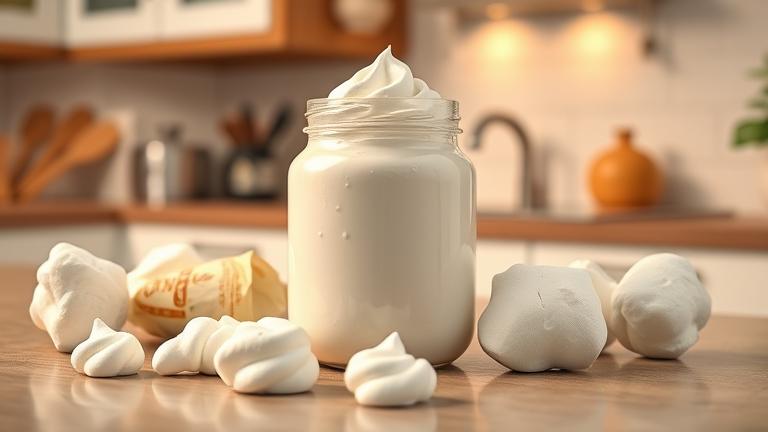Understanding Marshmallow Fluff: What It Is and Its Common Uses
Marshmallow fluff is a delightfully sweet and sticky spread characterized by its smooth, fluffy texture. It is primarily composed of sugar, corn syrup, and gelatin, which together create its distinctive consistency and sweetness. When combined with egg whites or additional flavorings, the fluff develops a rich and enhanced flavor, making it a versatile ingredient in the kitchen source.
This airy, sticky substance is most popularly used in a variety of desserts. It features heavily in fluffernutter sandwiches, which blend the sweetness of marshmallow with peanut butter for a nostalgic treat source. Additionally, marshmallow fluff is frequently employed as a frosting for cakes and cupcakes or as a key ingredient in no-bake recipes like bars and pie fillings source. Its mellow marshmallow flavor also complements other sweets, elevating simple treats into irresistibly creamy indulgences.
Proper Storage of Marshmallow Fluff
To maintain the freshness and quality of marshmallow fluff, proper storage is crucial. It should be kept in an airtight container that prevents exposure to air and moisture. Sealing it tightly helps preserve its creamy, spreadable texture and prevents it from drying out or developing mold source.
The ideal storage environment is a cool, dark place such as a pantry or cupboard. Exposure to direct sunlight or heat can cause spoilage and alter the product’s texture. In warm or humid climates, refrigerating marshmallow fluff can further extend its shelf life and prevent spoilage source.
When using marshmallow fluff, always use a clean, dry spoon to prevent contamination. After each use, ensure the container is resealed tightly to keep out air and moisture. Under proper conditions, marshmallow fluff can remain fresh for approximately six months or longer. It is advisable to inspect the product regularly for any signs of spoilage such as discoloration, off smell, or mold before use source.
Signs That Marshmallow Fluff Has Gone Bad
Visual and sensory cues are important indicators of spoilage. If you notice mold growth, discoloration, or a change in appearance from its normal fluffy white to yellow or darkened shades, it is time to discard the product. Mold is a clear sign that the marshmallow fluff has become unsafe to consume source.
In addition to visual changes, odors provide critical clues. An off or rancid smell suggests bacterial growth or fermentation, and the product should be discarded immediately. Texture changes, such as become excessively sticky, slimy, lumpy, watery, or extremely dry, also indicate deterioration source.
Always conduct a thorough inspection before using marshmallow fluff. If any abnormal signs are present, it is safer to discard the product rather than risk foodborne illness. When in doubt, it is better to be cautious and avoid using questionable products source.
Longevity and Factors Affecting Shelf Life
The shelf life of marshmallow fluff hinges on environmental conditions and storage practices. High temperatures accelerate spoilage and can alter the texture, while excessive moisture fosters mold growth. Tightly sealed, cool, and dry storage helps conserve its freshness source.
Proper handling—such as using clean utensils and minimizing exposure to air—can significantly extend its usability. When stored correctly, marshmallow fluff can stay safe and edible for several months up to a year. Once opened, it is recommended to consume within six months for optimal quality and safety source.
Regularly inspecting for signs of spoilage like mold, discoloration, or foul smell ensures you only consume safe products. If the fluff remains visually and olfactorily normal, it is likely still good to use source.
Guidelines for Using Expired Marshmallow Fluff
Deciding whether to use marshmallow fluff past its expiration date requires careful evaluation. Check the packaging for bulging or leakage, which can indicate spoilage source. If the product has an unusual smell or appearance, it should be discarded.
In particular, texture is a good spoilage indicator—if the fluff has become hard or clumpy, it might be past its prime. For expired products, consulting reputable sources or food safety experts can provide further guidance source.
Expiration dates serve as general guidelines, but always prioritize safety. When doubtful, it is better to discard questionable items to prevent potential health risks. Proper storage and regular inspections help extend the safe consumption window and ensure safety source.
Conclusion
Marshmallow fluff remains a beloved ingredient for its versatility and unique texture. Proper storage and regular inspection are vital for maintaining its freshness and preventing spoilage. Always rely on visual, smell, and texture cues to assess product safety before use source.
Understanding the signs of spoilage and handling it correctly ensures safe and delicious treats. Whether using fresh or slightly older marshmallow fluff, these guidelines help you enjoy this sweet ingredient to its fullest potential. Remember, when in doubt, discard and replace to guarantee safety and quality source.
Sources
- AllRecipes – Fluffernutter Sandwich
- CNET – How to Tell if Your Food is Spoiled
- Cheapism – How to Make Marshmallow Fluff Last Longer
- Earth.com – Best Storage Practices for Marshmallow Fluff
- FDA – Food Safety Tips and Info
- Healthline – Food Safety Tips
- Organic Authority – Are Marshmallows Safe to Eat After Expiration Date?
- USDA – Food Safety
- VeryWellFit – Food Storage Safety Guidelines
